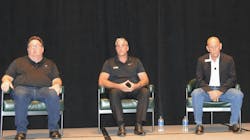Content brought to you by ABRN. To subscribe, click here.
What you will learn:
• What three technologies are disrupting collision repair
• What PPE a collision repair distributor can provide to its shops
• How artificial intelligence can quickly determine the majority of repairable vehicles
The annual Auto Care Association’s Paint, Body, & Equipment Specialists (PBES) Conference, part of Auto Care Connect Week, was held May 17-18 in Orlando, Fla. The final program discussed the role three technologies have in disrupting the collision repair industry: advanced driver assistance systems (ADAS), electric vehicles (EVs), and artificial intelligence (A.I.)
“As the years go on, ADAS is going to be one of the dominant technologies in the marketplace that your customers are going to have to deal with,” said panelist Frank Terlep, founder and CEO of Auto Techcelerators LLC. It’s important for repair shops – and the suppliers who serve them – to understand just how important to safety in steering and braking these systems are, he said.
Additionally, the complexity and unique characteristics of each manufacturer’s ADAS offerings will push collision repairers to specialize in which makes and models they repair.
“And the OEMs, through their certification programs, are also going to segregate the industry,” he said. “Because they're only going to allow shops that are certified in their program to be able to buy the key components or parts to be able to repair a car. You already see that in some OEM repair networks today. This is going to make major changes in the collision repair marketplace.”
Terlep advised that it’s not enough to only calibrate the ADAS after a repair; proper operation must be verified post-calibration.
The requirements of a shop for ADAS calibration – an extra three bays’ worth of space, equipment, and in trained people – open the door for enterprising distributors to venture into repairs by opening calibration centers that serve their customers, he noted.
“The margins are great and the opportunity is only going to go up.”
Battery electric vehicles demand understanding for safe repairs
The U.S. car parc grows increasingly electrified. In fact, Terlep noted, by 2024, there will be over 130 different EV models in the marketplace.
EVs are still much the same vehicle as an internal combustion engine (ICE) vehicle, with sheet metal and mechanical components that still get banged up and wear out.
But as Niel Speetjens, senior manager of ADAS/EV lab research and specialty training for I-CAR noted, their electrical hazards require due care. The 400-volt systems mean that only 400 milliamps can cause death if a technician pokes his or her fingers in the wrong spot (as with the more-familiar hybrid electric vehicles, keep away from the orange wires). Personal protective equipment (PPE), including but not limited to lineman’s gloves, a “shepherd’s hook” to rescue someone being shocked without the rescuer being shocked, and goggles are just a few of the PPE items a supplier can make sure its shop is using.
The batteries can be damaged in a collision or installation error, which can create a “thermal event,” or a fire that will be almost impossible to extinguish using conventional methods.
“If an EV car gets into a collision and there's a lot of g-force and abrupt stop on these battery cells, the internal guts of the battery could touch the inside of the container,” Speetjens said. “That will create resistance and later create a thermal event. So in our safety education at I-CAR, one of the first things we do is educate the people that when you get a vehicle like this in the shop you do a post scan. You start looking inside the battery with your scanner, seeing if the battery cells’ voltages are all equal [to assess their integrity], and you keep monitoring that.”
The electrical connectors for the high-voltage battery demand respect not only for technician safety but to ensure a safe vehicle after the repairs, Speetjens cautioned. A slight amount of paint overspray and dirt in an open electrical connector can result in a slight difference in resistance, from 1 milliohm to 10, which may not sound like much, but it’s enough, he said, to cause a thermal event.
“Keeping dirt and dust out of these connectors is crucial for the lifespan of these vehicles,” he said.
A.I. can quickly assess vehicle total losses and reduce cycle time
Artificial intelligence (A.I.) allows a computer to use machine learning and computer vision to be able to recognize images and make decisions. A.I. can thus quickly assess the majority of the needs for a collision repair estimate or rapidly assess the condition of vehicles of a large fleet, as examples of its best use cases, said Jimmy Spears, head of Automotive for Tractable, a company which develops A.I. for accident and disaster recovery.
The technology is not expected to replace the need for an experienced estimator to assess damage on every vehicle, Spears noted. An insurance company in the United Kingdom had repairers with an average cycle time of about 16 days before the A.I. was implemented.
“What we worked on with them was the recognition of if a car is repairable or not repairable,” Spears said. “That’s one of the most important decisions: ‘Is that car going to go down a path where it's going to stay and it's going to be repairable? Or is it going to go down a path where it's going to be not repairable and then it gets towed to a salvage yard and eventually gets sold? We were able to reduce that down well below five days.”
The technology improves its accuracy with each use, just as a human estimator does…or in Spears’ case, his own son, who at a tender age was around his father’s insurance appraisal activities enough to pick up the basics.
“At six years old, my son could go out in the parking lot and I could say, ‘Take your right hand and put it on the right fender of a car,’” he recalled. “’Tell me if it has damage and you think we're going to have to replace that fender, or do you think we could actually fix it or buff it out,’ something like that. He could make that decision. This is what our A.I. does. It takes a look at a vehicle panel by panel, and it doesn't need to have the VIN to know that it's a 2020 Ford F-150. It knows it's a truck and it knows it's a fender on a truck.”
The process requires an estimator to do a quick walk-by of the vehicle and scan using the Tractable app on a smartphone, which will also prompt the user to adjust scanning technique, if necessary.
“It scans pixel by pixel,” he said. “And then it's calibrated to detect damage, and if it is damaged, how much. It has been trained to know how much damage this should be: two, three, four units or whatever people want to put on it, and if it's beyond a certain point this panel needs to be replaced.”
The technology is accurate enough to remove the need for an initial human estimate on 80 percent of collision-damaged vehicles, Spears said, which allows the shop’s estimator more time to build a rapport with the customer instead of building the estimate.
“An estimate is only a document of decisions that you've looked at a vehicle, you looked at every part, and you've made some type of decision: Do you repair or replace, or what you do on this? and we do the same thing for paint and the same thing for paint blends as well.”
Terlep noted A.I. is not completely replacing a human set of eyes anytime soon.
“If you ask 10 people to write an estimate on the same car for the same damage, you're going to get 10 completely different estimates. With A.I., what you're going to typically a standard deviation between those 10. It's going to be pretty close, and then the estimator will use that information to make additional decisions related to the repair of that vehicle, because you're very hard to replace.”
About the Author
Jay Sicht
Editor-in-Chief, FenderBender and ABRN
Jay Sicht is editor-in-chief of FenderBender and ABRN. He has worked in the automotive aftermarket for more than 29 years, including in a number of sales and technical support roles in paint/parts distribution and service/repair. He has a bachelor's degree in journalism from the University of Central Missouri with a minor in aviation, and as a writer and editor, he has covered all segments of the automotive aftermarket for more than 20 of those years, including formerly serving as editor-in-chief of Motor Age and Aftermarket Business World. Connect with him on LinkedIn.
Don't miss Jay's next article or podcast. Sign up for FenderBender Today's Collision Repair News and ABRN eNews here.

